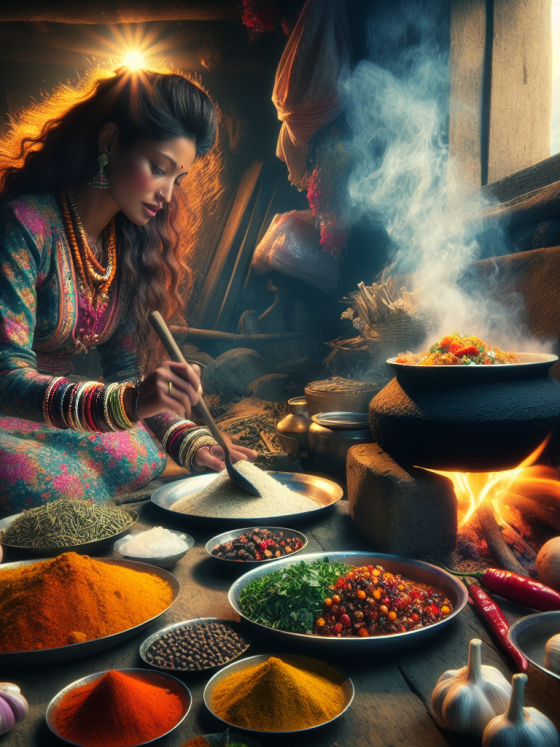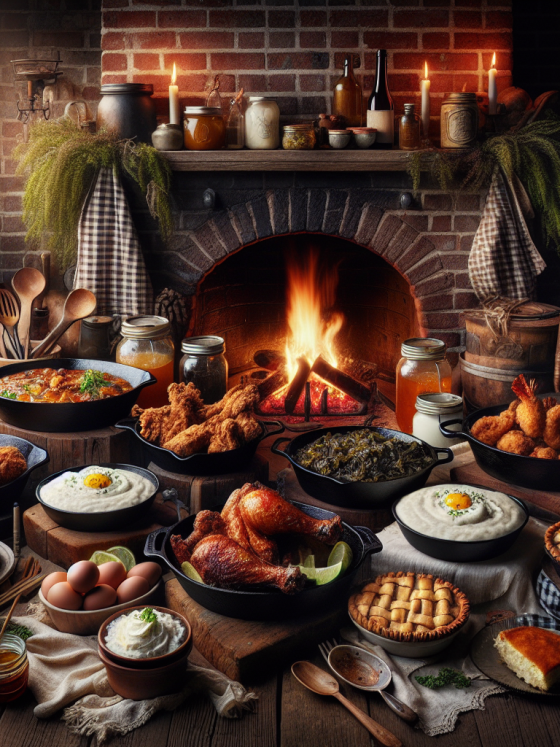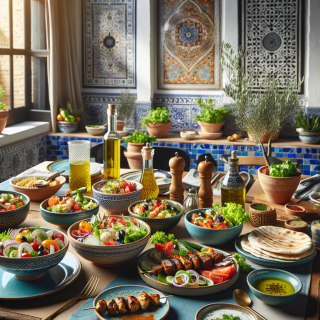Exploring the Rich Flavors and Traditions of the Chinese Kitchen

The introduction to Exploring the Rich Flavors and Traditions of the Chinese Kitchen by Nancy Ying + Phillips-Barton sets up an appropriately grand spanning background for a diverse, ancient cuisine with thousands of years worth of culinary culture across its many regions. Chinese cuisine ranges from the fiery spices of Sichuan to the light, subtle flavors in Cantonese cooking like sweet shares that perfect harmony between taste and technique. But come on, each dish speaks to the storied agricultural history of China and local produce consumed over centuries often cooked in a specific way dictated by geography or historical trade routes back as far back as those ancient dynasties.
Chinese food is not about just tasting the diversity of its cuisine, it brings in centuries-old traditions and norms related to family values around soul-satisfying food gatherings or some ingredient signatures having poetic symbolism very well aligned with philosophies like Yin and Yang dictating our dietary choices. The Chinese Kitchen takes us into this beautiful world of one-sixth or the 1.4 billion people living in China, where food is not just nutritional value but also a social and spiritual site that shows their ingenuity from generation to generation.
Historical Background
It was designed to make sure no proofs could be excluded and is so broad that it includes nearly every aspect of the history, culture, labor practices as well as safety measures surrounding Chinese food. Chinese kitchen offers a vast culinary legacy; covering five millennia with flavors reinventing themselves over time along distinct dynasties in different regions across China since its inception.RELATED POST: 10 KITCHEN UPGRADES THAT ARE THE BEST AGAINST NOISE Because China boasts every atmospheric condition, from lush river valleys to bone-dry deserts (not really), the development of Chinese food is like an exciting episode in a time-traveling sci-fi. In the development process of gardens, many princes once refined techniques and recipes for courtyards from imperial dynasties to modern years. In the Tang and Song dynasties (7th to 13th centuries), trades along the silk road had contributed spices as well cooking methods which developed local dishes. The culture of harmony and balance underlying Confucianism, influencing Taoist ideas as well compels to the significance of taste, texture touch with nutrition in cooking. Chinese is the combination of stir-frying, steaming and braising simmer methods as one of taking into account long-term development traditional foodstuffs, reflects the Chinese people with simple natural flavor. This history tapestry weaves its way into the rich, and layered flavours that make Chinese food what it is today.
Ancient Chinese Culinary Traditions
Requiring centuries to develop, ancient Chinese cooking traditions are connected through China’s richly intricate history and its dynamic philosophical beliefs having been deeply woven into the culture. Different Chinese cuisines originate from 8 regions of the myriad-flavored China. As I’ve already stated, Chinese philosophy makes an enormous impact on its culinary culture-Confucianism claims that there must be a balance and harmony of flavors in food (they need to complement each other), which is why we can always correct the amount of salt or any spices as well. It harkens back to centuries-old methods of stir-frying, steaming and slow-cooking mastered by Chinese chefs long ago. As well as offering an intriguing selection of essential condiments (soy sauce, ginger, garlic), the fragrance-heavy herbs and spices denote a larder designed to rouse you from your seasoning slumber with ritual every time there’s fleeting change in season or blocks traversed on foot. They show how the rules of civilised behaviour were taken to extremes in formal table manners and extended even into shortbread, while also illustrating that myriad culinary artists would spend hours on elaborate banquets served for festivals only once a year, expressing culture through food long after taste had turned stale.
Influence of Dynasties on Cuisine
Each dynasty has produced a cuisine of its own and played their part in influencing the Chinese culinary traditions. The Tang Dynasty (618-907 A. D.), which is generally considered a high-point in Chinese civilization and an empire of opinion, ushered in the burgeoning inflow of exotic herbs and skills with through The Silk Route. The Song Dynasty (960-1279 AD), meanwhile, established a more sophisticated and cultured culinary culture that utilized presentation styles and specific forms of food preparation similar to the modern artful dishes as we know today like dim sum. And during the Ming Dynasty (1368-1644 AD), when New World foods such as sweet potatoes, maize and peanuts started to appear in Chinese cuisine, a much broader range of tastes — not only flavor-wise but also in terms of nutritional value was introduced. Finally, the Qing Dynasty (1644-1912 AD), famous for confining culinary geography to regions such as Sichuan, Shangdong,, Guangdon and Huaiyang characterized by their different tastes and cooking types. Over the centuries, the interaction between imperial court cuisine, locally produced styles and foreign influences in China have significantly contributed to what it has become–a colorful quilt of tastes that range from mild to spicy.
Regional Diversification Over Time
The vast expanse of China’s terrain has influenced an extraordinary culinary patchwork over the centuries, with every region lending a particular flavour and cooking heritage to the fabric. It is basically defined by the Eight Great Cuisines of China: Sichuan, Guangdong (Cantonese), Shandong, Jiangsu,Zhejiang,Fujian somewhat sometimes considered separate groups) Hunan and Anhui. Every food culture draw from the climate, agriculture and cultural history of a place. One example is the pungent, spicy flavors of Sichuan cuisine due largely to the excessive use of chili peppers and Sichuan peppercorns or szechwan pepper in its natural habitat where you can find a humid climate. By comparison Cantonese cuisine is a celebration of fresh ingredients and subtle seasoning, an art that honed over the centuries from abundant resources in the Pearl River Delta. Migration and trade have also modified local areas by introducing new foods, cooking styles, tools and goods over time. But this gradual evolution itself reflects the vibrancy of Chinese culinary traditions, evolving with every generation while retaining the core flavours and soul through each region.
Key Ingredients and Techniques
As one of the oldest cuisine with a vast and diverse range of ingredients prevalent in their kitchens, Chinese menu has depth that’s unmatched by any other. Essential things like soy sause,rice vinegar and sesame oil are base for a lot of dishes, some meals couln´t taste without them Spices as ginger garlic or star anise provide extraordinary tastes. Traditional Chinese ingredients such as tofu, bok choy and a variety of mushrooms capture the taste and healthy nature.
This would respect the traditional Chinese cooking arts, including stir-frying (炒), steaming(蒸) or braising techniques. Flavor and freshness are kept intact by the quick-cooking method of stir-frying since it takes place at a high heat. Steaming is considered a healthy method of cooking by many since no fats or marring agents need to be added in order for the food to cook and it retains its natural flavors, also making ideal prep technique for delicate items such as fish & dumplings. More common with tougher meats, braising draws out deep savoury notes.
Together, these ingredients and techniques showcase the delicate balance and entire craftsmanship that represents Chinese cuisine- providing a new form of dining experience spotlighting tradition with forward innovation.
Staple Ingredients: Rice, Noodles, and Tofu
Rice, noodles and tofu are staples of the food culture in China, but each can also be so unique that they have become essential building blocks of different regional flavors. An essential part of the Chinese table, rice is a chameleon: not just dinner-table bland, but also transformed into congee (rice porridge), fried rice and nian gao – sticky glutinous cakes. Its value attest to regional differences, from aromatic jasmine rice in the south to short-grain sushi rice in the north.
Another staple which bears witness to the cultural and culinary heterogeneity of China is noodles. From the threads that appear in Northern Chinese delicate hand-pulled noodles, to Southern rich egg based strands you will find these essential for dishes such as Sichuan’s dan dan noodles or even Beijing zhajiangmian.
The Chinese masters of tofu demonstrate the adaptablility and nutrient-richness that are a basic principle behind traditional Oriental cooking. The spice is excellent at soaking up flavors, which instantly places it in the very best food pairing list (it works well with vegetarian and meat dishes alike > just look into Mapo tofu ). Rice, noodles and tofu (especially when combined) serve as its base — providing a reminder of the multiple layers found within Chinese cuisine that are often overshadowed by stereotypes.
Common Spices and Herbs: Ginger, Garlic, Scallions
Chinese cuisine’s emphasis on flavors that taste great together and a myriad of fragrant herbs will lead you to cook more flavorful food long after your time with this vba. There are also the much more basic and usable ingredients of ginger, garlic, scallion. These three are common elements in Chinese cuisines and not many would have that amplified flavor hence you can enhance your dishes without having to worry about overpowering any one of this ingredient.
Its warm, spicy and slightly sweet taste makes ginger a staple ingredient in stir fries, soups and marinades. It not only gives a tangy flavor but is also composed of anti-inflammatory and digestive compounds. Another cornerstone is garlic, raw and fierce in a way that turns smooth and tender when stewed. However, when it is cooked through and takes on a golden brown color via stir fry or added into thick sauces for extra flavor.
Scallions (green onions)- Scallions have a mild onion flavor with a touch of sweetness. On the one hand they are an aromatic base and on the other a fresh topping that adds crunch of color as well. Ginger, garlic and scallions are central to many a traditional recipes: the base upon which countless symphonies of taste explore the boundaries of Chinese culinary art.
Cooking Methods: Stir-Frying, Steaming, Braising
An entire universe of flavors and textures that the Chinese kitchen is famous for, due to its many different ways… Stir-frying is a technique often associated with Chinese cuisine, in which ingredients of varying sizes are chopped to same-sized form pieces and quickly cooked utiizing small oil on hot wok. The ingredients in the pot share aromas while cooking, with garlic, ginger and soy sauce often included at different times so they do not over power other flavors.
Another vital method is steaming, much appreciated for its ability to keep all the flavors and nutrients of your food. Steam: Steam is gentle and cooks delicate dishes like steamed fishets, dumplings grasjts and buns without adding any fat to them.
One of the most flavourful methods is braising, a combination of moist and dry heat that usually involves browning the item first in fast-cooking at high temperatures followed by long slow cooking (l ow-temperature) final period covered resting in a flavored broth. This is also a great method for longer cooking times so the more challenging meats become tender and filled with rich flavors. Revering the purity of raw materials and balancing flavors in harmony, this is how Chinese kitchen performs its sorcery.
Signature Dishes
Chinese cuisine is a blend of countless palates from every region and province in the land, all serving up their own distinctive dishes that seduce taste buds around the globe. There are the fiery, bold spices of Sichuan cuisine and delicate umami-rich flavors with Cantonese dishes — China is a huge country after all. Peking Duck: This Beijing specialty always has the crispy skin and juicy meat perfectly paired with thin pancakes and hoisin sauce. Sichuan Mapo Tofu is cooked with ground pork and a sauce heavily seasoned by Szechuan peppercorn for an addictive numbing spicy flavor profile. Another popular Cantonese specialty, dim sum are small bites in the form of dumplings, buns and rolls — perfect for a leisurely brunch. The dishes in Chinese Cuisine are authentic reflection of ingredients available from the land, practices employed while cooking and cultural heritage that makes each dish a unique tapestry that’s different than any other else thus bringing unparalleled variety.
Peking Duck: Preparation and Significance
A piece of art that embodies the flavour and richness in Chinese cooking is Peking Duck. A dish originally from Beijing, now an icon of Chinese cuisine for its elaborate preparation and cultural heritage. We select a certain duck breed, which grows tender meat with thick layers of fat. Seasoned, air-dried and then roasted until the skin is crisp as a cracker while the meat beneath remains juicy. Part of its preparation indeed involves blowing the duck up with air to loosen the skin from fat, delivering a crunch that is just fantastic.
As tradition goes, Peking Duck is paired perfectly with thin pancakes that you can fill up yourself with scallions and cucumber strips then topped or painted light using some sweet bean sauce. It is a DIY wrap job but since you know best the flavors and texture combos that tip your taste buds scales, let diners jam unadorned wraps into every available millimeter of pupusa-accessible space. While this is a total culinary joy–the minute details of preparing and serving such unlikely dishes in the big banquet or at other special occasion meal. It dates back to imperial China, the dwindle of kings and royalty turned it into what is a proud dish unto this day.
Dim Sum: Variety and Dining Experience
More than simply a meal, it’s also an all-encompassing dining experience of the Cantonese cuisine known as dim sum and celebrated for its diversity in taste that forms part-and-parcel with this social aspect. Typically served in bite-sized portions, dim sum consists of various types of steamed buns such as dumplings and potstickers but can also include rolls and other light cakes. Every painstakingly created dish celebrates the creativity and artistry of Chinese culinary heritage.
The experience is unlike any other — brunch in lively tea houses, served by staff who wheel trolleys piled high with bamboo baskets for diners to peruse before selecting their heart out. Served family-style, this style of communal eating fosters sharing and conversation that has a definite social aspect to the meal. Whether it’s the dainty shrimp dumplings (har gow) or the fragrant custard buns (nai wong bao), dim sum presents an array of flavors and textures that has captured hearts worldwide as a favorite culinary tradition.
Hot Pot: Communal Eating Tradition
Hot pot is a Chinese tradition as beloved for the pure pleasure of eating and sharing good food,creating intimate time together with loved ones. It was evolved 2 times in the Mongolian Empire more than a thousand years ago and is set with aluminum pot flavoring broth to taste on your own by using a selection of uncooked substances, such as frosting sliced meats, clean veggies., tofu: noodles Each varietally (& quite literally) unique meal offered in this format represents a pot of ingredients that diners cook individually inside the communal cauldron to create their true-to-tongue selections for dinner.
Hot pot also creates an incredibly interactive and communal experience — one in which conversation is encouraged just as much, if not more so than other types of dining experiences. regions of China have developed different styles of hot pot, using differences in ingredients and spice; examples include the use of numbing sichuan pepper extract or mild fresh cantonese soup base. And so we can say with certainty that hot pot is no mere sustenance; it has transformed its way of eating into an institution for community, flavor revelation and the bold tapestry of Chinese culinary practice.
Cultural Significance
By decoding the cultural history of Chinese cuisine, we can see how centuries-old tradition, philosophy and social values are interwoven into a complex tapestry. Every dish — from humble bowl of congee to the grand spectacle of Peking duck — is riddled with symbolism and historical dignity. Yin and Yang are also closely associated with culinary traditions in China, which aim to be deeply harmonious not just for an individual’s health but also the general harmony of society. Food also has a major role in festivals and family reunions, binding communities through the stomach as they honor ancestors. Noodles symbolize long life, fish means prosperity, so these meals are not just nutritious in body but also the soul. The regional range further testifies to vast geographical and cultural breadth that defines China, from the fiery spices of Sichuanese food to the light touch in Canton. By gaining tremendous insight from Chinese food, an American is connecting with the culture and principles of China — it’s a colourful invitation to its past.
Symbolism in Food: Colors and Ingredients
Colorful and ingredient-laden, Chinese food clearly provides rich perpetuated symbolism but in a completely different way. What is relevant here however, is that red represents prosperity and joy in Chinese colors (which includes colorful food such as pomegranates or dishes with some fresh chili peppers), and hence you are supposed to avoid this color of foods during Lunar New Year. The color of wealth and prosperity, yellow be seen in everything from egg yolks to golden hues like stir-fried corn.
The ingredients themselves are also heavy with symbolism – the word for fish in Mandarin is “yu”, a homonym of surplus and abundance, meant to herald prosperity (hence plentiful fish dishes during celebrations). And even in birthdays, noodles are a must on the menu to give out birth for somebody long life because it’s looong. Even pocket-size dumplings, molded in the shape of a coin from ancient chinese currency are loaded with cash MatTableClosing systemFontOfSizecale.
These beautiful similes do not just enhance the dinning but provide an opportunity to everyone for homage old yet compelling customs and thus bringing a cultural continuum within itself.
Festivals and Food: Mooncake Festival, Chinese New Year
In Chinese culture where festivals and cuisine are inextricably linked, it is not uncommon for every festival to come with special dishes that have meaningful connotations. In the case of Mid-Autumn Festival, mooncakes are front and center. The round, sweet pastries signify reunion and togetherness as they take the same shape of a full moon. This has become a fun family occasion to bond while feeding one another with these delicious treats, usually made in flavours such as lotus seed paste or red bean paste and salted egg yolk on the itself inside.
The colourful Chinese New Year (Spring Festival) is marked with many symbolic food-related customs and traditions. These are dumplings, symbolizing a kind of Chinese money called an ingot (and therefore wealth). Fish is served whole to show surplus and wealth, sticky rice cakes (nian gao) mean more highly achievement, dumplings as a symbol of good fulfillment.– Their consumption is a way for people to not just enjoy the palate but also build family ties, and they tie into their cultural roots — every morsel consumed doubles up as an ode to tradition and communal harmony. This makes an interesting gastronomical journey through the colourful culinary map of China at its varied festivals.
The Role of Food in Family and Social Gatherings
Food is central to Chinese culture, more than merely filling one’s stomach but as a means of connecting and showing love, respect for our community. Through the act of preparing and consuming a meal as groups, be it friends or multiple generations, food nurtures relationships across many traditions. This is most prominently seen during festivals — such as Chinese New Year or the Mid-Autumn Festival, where feasts autocatalyze; each dish resonating symbolic meanings which sounds blessings and good fortune. Banquet-style dining: Using a round table for Chinese banquets and eating with others (social setting): While Western values individuality, separation from community, focused on taste pleasure rather than meal sharing in group meals In contrast to these trends of the Eastern mode of banquet style highlights everyone at same location is equal amount all other individuals. In addition to this, table manners (among which the ritual of always giving away richer parts in a meal) are important as part of indirect principles concerning hospitality and respect. Therefore, in the Chinese cuisine food is more than just nutrition: it constitutes a trump card capable of articulating social and family life.
So what have we concluded?
All in all, the trip to Chinese Kitchen leads one full circle into a momentous culture known for its great taste and customary beings. Here, the Chinese culinary tradition embraces colour and variety with an ardour that captivates all five senses – from busy markets rampant in fresh ingredients, to intricate techniques passed down through generations. Every dish, be it a delicate dim sum or hearty Peking duck can be seen as the source of origin and historical evolution. Chinese cooking is rooted firmly in the philosophy of equilibrium, balancing Yin and Yang to guarantee vibrant health for our minds and bodies through conscious consumption. By taking our time to savor these carefully prepared foods, we taste and experience the lingering flavors of Chinese history which serve as building blocks for vibrant roots in community. Hence the Chinese kitchen is not only about making food; it serves as a slice in inquiries on an ancient and changing culture.







